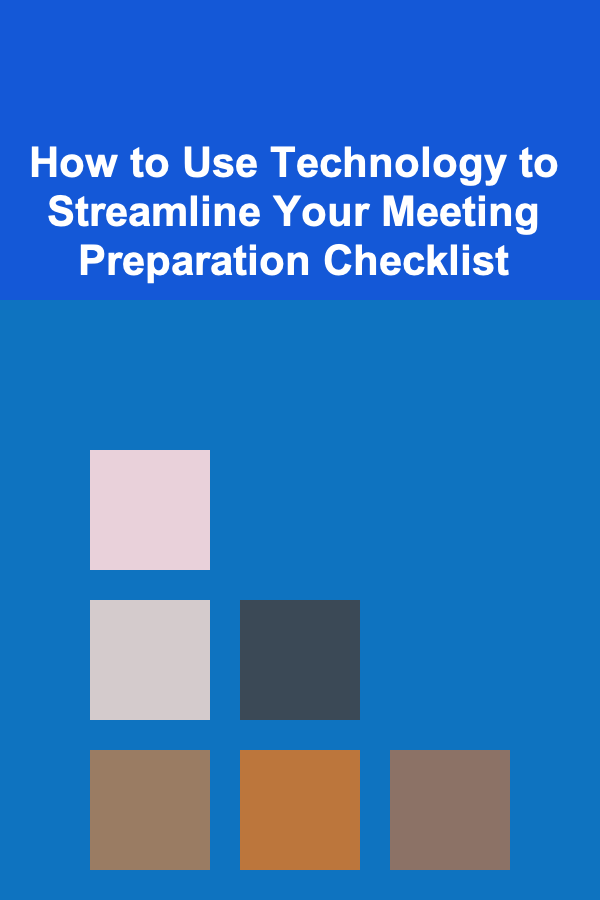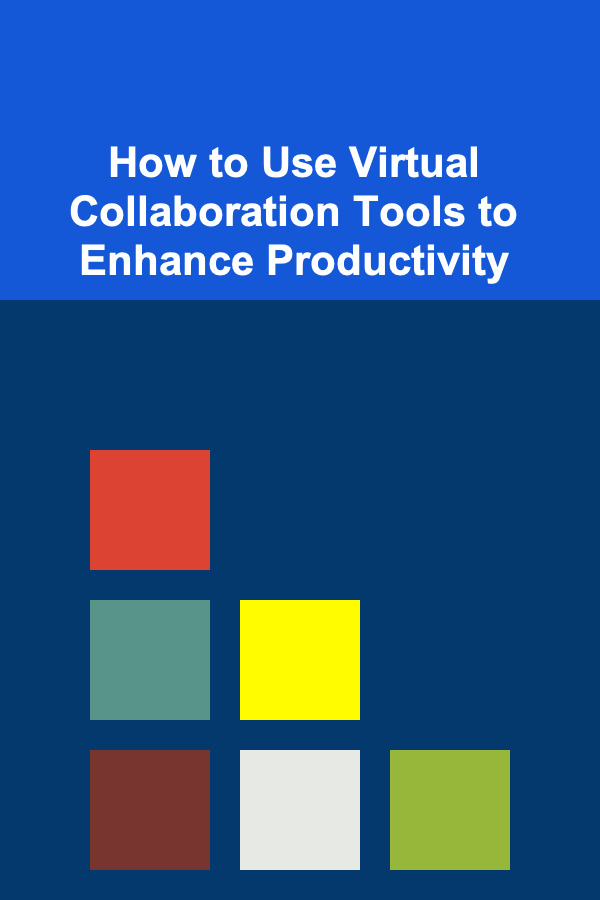
How to Use Technology to Streamline Your Meeting Preparation Checklist
ebook include PDF & Audio bundle (Micro Guide)
$12.99$5.99
Limited Time Offer! Order within the next:

In today's fast-paced, digitally-driven world, managing meetings efficiently is crucial. Technology can simplify the entire meeting preparation process, ensuring that all the necessary elements are in place before the meeting begins. Whether you're organizing a small team huddle or a large corporate meeting, leveraging the right tools can save you time, reduce stress, and increase productivity.
This guide will explore actionable steps to use technology to streamline your meeting preparation checklist, covering tools and strategies for scheduling, collaboration, communication, documentation, and follow-up.
Automate Meeting Scheduling
One of the first steps in any meeting preparation is scheduling. Traditional methods like email back-and-forth or manually checking calendars are time-consuming and often lead to confusion. Fortunately, scheduling tools and apps can eliminate this hassle, providing a more efficient way to set up meetings.
Tools to Use:
- Google Calendar / Microsoft Outlook: Both platforms have built-in scheduling features that allow you to set meeting times, invite participants, and track responses. Integration with other tools ensures seamless coordination with your team.
- Calendly: This tool allows participants to select a time from available slots, eliminating the need for constant back-and-forth emails. It also integrates with Google Calendar and Outlook.
- Doodle: Doodle simplifies scheduling by letting participants vote on their preferred meeting times. This is particularly useful for group meetings with multiple attendees who have conflicting schedules.
Actionable Steps:
- Integrate Calendars: Sync your work calendar with scheduling tools like Calendly or Google Calendar to see real-time availability.
- Set Buffer Times: Avoid back-to-back meetings by setting buffer times between meetings to allow for preparation or catching up.
- Send Automatic Reminders: Use scheduling tools to send automatic reminders to attendees, reducing the chances of no-shows or delays.
Why This Matters:
Streamlining scheduling not only saves time but also ensures that your meetings start on time with all the necessary participants present. Automated reminders help prevent the chaos that often comes with last-minute reschedules or missed meetings.
Collaborate Using Cloud-Based Document Management
A critical part of meeting preparation is gathering and sharing information. Cloud-based document management platforms allow teams to collaborate on documents in real-time, eliminating the need for constant file-sharing emails or version control problems.
Tools to Use:
- Google Drive: Allows for real-time collaboration on documents, spreadsheets, and presentations. Team members can leave comments and edit documents simultaneously, ensuring up-to-date versions.
- Dropbox Paper: Offers collaborative note-taking and document editing features that can be integrated with your Dropbox storage.
- Microsoft OneDrive: A part of the Microsoft 365 suite, OneDrive offers cloud storage with collaborative features that work seamlessly with Microsoft Office apps.
- Notion: A flexible tool for managing documents, tasks, and notes, Notion enables teams to create meeting agendas, assign tasks, and track action items all in one place.
Actionable Steps:
- Create Shared Folders: Set up shared folders in Google Drive, Dropbox, or OneDrive where all meeting-related documents can be stored and easily accessed by participants.
- Set Permissions: Ensure proper access levels are set for each team member, so only relevant people can edit or view specific documents.
- Use Version Control: Always save files with clear version names, so everyone is working with the most recent document. Tools like Google Docs automatically manage versions.
Why This Matters:
Using cloud-based tools ensures that everyone is on the same page before the meeting. It streamlines document sharing and allows team members to collaborate efficiently, resulting in better-prepared meetings.
Prepare Agendas and Share Them in Advance
A detailed meeting agenda is essential for guiding the discussion, staying on track, and achieving objectives. Technology can help you easily create and distribute meeting agendas in advance, giving attendees the opportunity to prepare adequately.
Tools to Use:
- Trello: A project management tool that allows you to create boards and lists for meeting agendas. Each card can represent a specific agenda item, and you can assign deadlines and responsibilities.
- Google Docs: Create a shared agenda document that can be edited and accessed by all participants, allowing for collaboration on topics and priorities.
- Asana: Asana's task management system can be used to create meeting agendas by breaking down each agenda item into actionable tasks, making it easy to track progress.
Actionable Steps:
- Create a Standard Agenda Template: Whether in Trello, Google Docs, or Asana, use a template that includes sections for meeting objectives, discussion topics, action items, and assigned responsibilities.
- Share Agendas Early: Distribute the agenda at least 24-48 hours before the meeting to give participants time to prepare.
- Encourage Pre-Meeting Input: Allow attendees to add their own topics to the agenda before the meeting starts. This will ensure that all important issues are addressed and give attendees a sense of ownership.
Why This Matters:
Sharing the agenda in advance sets clear expectations for what will be covered, which helps attendees prepare for the meeting. This increases the chances of a productive and focused meeting.
Use Video Conferencing and Communication Tools
In remote or hybrid work environments, video conferencing and communication tools are crucial for facilitating collaboration and maintaining clear communication before, during, and after meetings.
Tools to Use:
- Zoom / Microsoft Teams: These platforms are essential for hosting video meetings, sharing screens, and recording meetings for future reference.
- Slack: A messaging platform that enables real-time communication, file sharing, and the creation of channels for specific meetings or projects.
- Google Meet: Integrated with Google Workspace, Google Meet allows for video calls and screen sharing directly from your Google Calendar.
Actionable Steps:
- Set Up Virtual Meeting Links: Use Zoom, Google Meet, or Microsoft Teams to generate unique meeting links and include them in your calendar invites.
- Enable Meeting Recording: Record your meetings for reference and share them with absent team members. This helps everyone stay on track and allows you to revisit discussions.
- Use Breakout Rooms: In video conferencing tools like Zoom, use breakout rooms for smaller group discussions during larger meetings, promoting more focused collaboration.
Why This Matters:
Video conferencing allows for a more interactive and engaging meeting experience. It also helps bridge the communication gap in remote work scenarios, ensuring that all participants are engaged and have the opportunity to contribute.
Set Reminders for Pre-Meeting Preparations
Proper meeting preparation extends beyond just the agenda and documents. You'll want to make sure that all logistical details are taken care of, such as testing equipment, ensuring all participants have necessary access, and confirming any external contributors.
Tools to Use:
- Todoist: A task management tool that helps you create a to-do list with checklists and deadlines to stay on top of meeting preparation tasks.
- Microsoft To-Do: Another great tool for tracking meeting preparation tasks, ensuring that every detail is covered before the meeting.
- Trello: You can also use Trello to set up tasks for meeting preparation and assign team members specific responsibilities.
Actionable Steps:
- Create a Pre-Meeting Checklist: List all necessary tasks, such as checking equipment, confirming attendance, ensuring materials are ready, and testing software.
- Set Reminders: Use tools like Todoist or Trello to set reminders for when tasks need to be completed. For example, remind yourself to test video equipment an hour before the meeting starts.
- Delegate Tasks: Assign preparation tasks to relevant team members, ensuring that everyone knows their role and responsibilities in the lead-up to the meeting.
Why This Matters:
Having a well-organized checklist and automated reminders reduces the risk of forgetting essential details. This ensures that the meeting can start smoothly and that no critical steps are missed.
Capture Meeting Notes and Action Items in Real-Time
Once the meeting begins, technology can continue to support your preparation by ensuring that accurate notes are taken and action items are clearly defined and tracked.
Tools to Use:
- Evernote: A note-taking app that allows you to capture meeting minutes, action items, and ideas in real-time. You can organize notes by meeting date and project for easy retrieval.
- Notion: Use Notion to create collaborative note templates where attendees can contribute to the meeting minutes and track progress on action items.
- Google Docs: A simple tool for taking real-time notes and sharing them with all participants. Google Docs also allows for easy collaboration and edits during the meeting.
Actionable Steps:
- Designate a Note-Taker: Assign someone to take notes during the meeting, or use a collaborative platform where everyone can contribute.
- Create Action Items: After each discussion point, make sure to record actionable tasks with clear deadlines and assign responsible individuals.
- Share Notes Immediately: After the meeting, share the notes and action items with all participants. This ensures that everyone is on the same page and accountable for their tasks.
Why This Matters:
Real-time note-taking ensures that no important information is lost during the meeting. Clear action items also improve follow-up and accountability, which is essential for achieving meeting objectives.
Conclusion
Technology can significantly streamline the meeting preparation process, from scheduling and document sharing to collaboration and follow-up. By leveraging the right tools, you can save time, reduce stress, and ensure your meetings are productive and efficient. Whether you're a small team or part of a larger organization, these technology-driven strategies will help you better manage your meetings, drive outcomes, and foster collaboration.
By adopting these tools and strategies, you can take your meeting preparation to the next level, ensuring that every meeting is organized, well-planned, and productive.
Reading More From Our Other Websites
- [Survival Kit 101] Top 10 Items Every Urban Survival Kit Should Include
- [Home Renovating 101] How to Improve Home Energy Efficiency During Renovations
- [Home Holiday Decoration 101] How to Make Your Christmas Tree Stand Out with Unique Decorations
- [Digital Decluttering Tip 101] Best Tactics for Simplifying Digital Calendars in High‑Growth Start‑ups
- [Home Cleaning 101] How to Clean Your Home When You Have Allergies
- [Home Staging 101] How to Stage a Home to Appeal to Millennial Buyers
- [Home Space Saving 101] How to Use Vertical Space to Save Room in Your Home
- [Organization Tip 101] How to Organize Your Makeup Collection by Category
- [Beachcombing Tip 101] How to Decode Ancient Indigenous Shell Mosaics Discovered While Beachcombing
- [Home Lighting 101] How to Use Lighting to Bring Focus to Your Home's Features

Freelancing vs. Full-Time Employment: Which is Right for You?
Read More
How to Make Money Online as a Freelance Writer
Read More
How to Use Customizable Digital Templates to Make Money
Read More
How to Use Virtual Collaboration Tools to Enhance Productivity
Read More
The Ultimate Guide to Utilizing Loyalty Programs for Smart Shopping
Read More
How to Fuel Your Body for Exercise
Read MoreOther Products

Freelancing vs. Full-Time Employment: Which is Right for You?
Read More
How to Make Money Online as a Freelance Writer
Read More
How to Use Customizable Digital Templates to Make Money
Read More
How to Use Virtual Collaboration Tools to Enhance Productivity
Read More
The Ultimate Guide to Utilizing Loyalty Programs for Smart Shopping
Read More